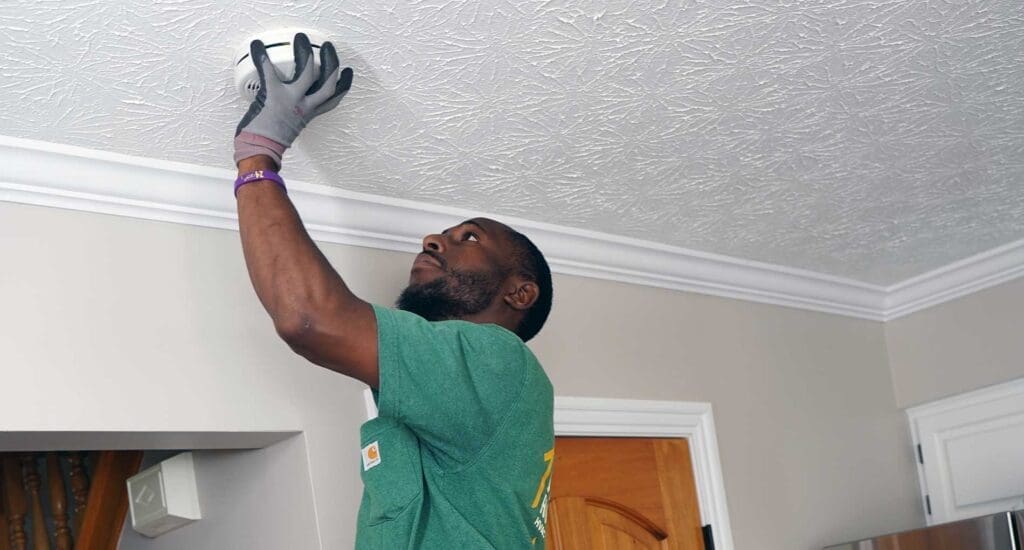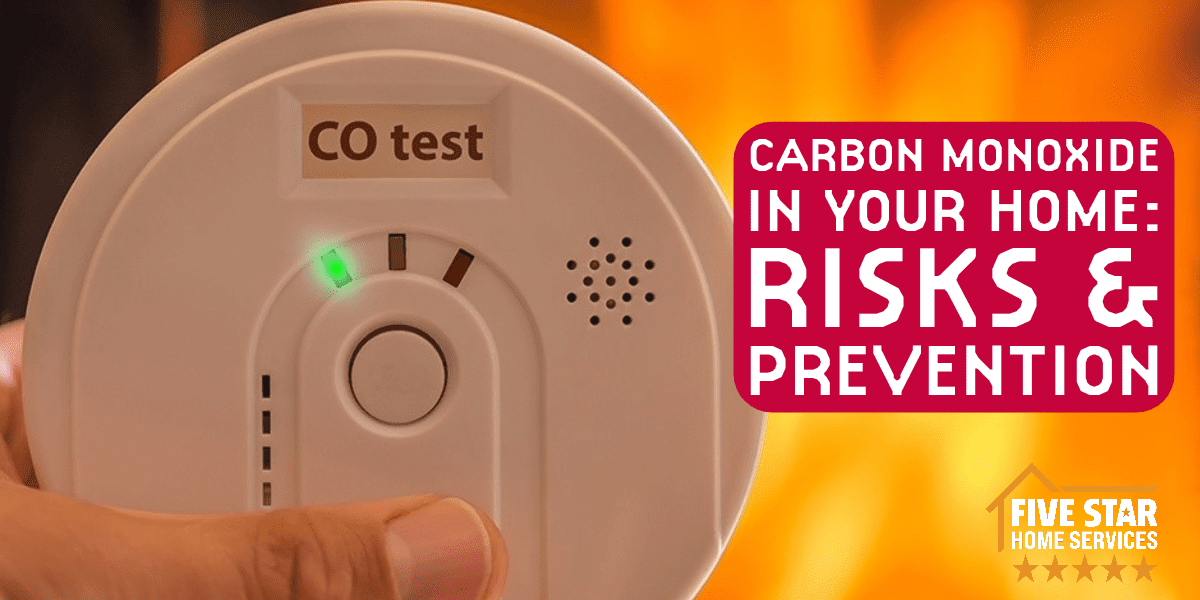A known silent killer, carbon monoxide is odorless and dangerous when it concentrates at high levels. We at Five Star Home Services encourage homeowners to know the steps to take to minimize their risk.
Carbon Monoxide in Your Home: Risks & Prevention
Carbon monoxide is known as “the silent killer.” It is a smokeless and odorless gas. Normally, carbon monoxide can’t be detected by our senses. In high enough doses, however, it can kill. Even at lower-than-lethal levels, there can be serious health risks associated with carbon monoxide.
When it comes to something as serious as carbon monoxide, nevertheless, it can be easy to inspire fear.
Rather than trying to come at it from that angle, we want to inform you on the topic in a way that will minimize any future risks and give you peace of mind. When it comes to your HVAC system, comfort is also in knowing you are safe.
Areas of Carbon Monoxide Risk
Although we will focus a lot on HVAC equipment in this article, it isn’t the only source of CO in the home. Other items that can contribute to CO levels include the following:
- Ovens or fireplaces that use wood as fuel
- Your dryer unit (assuming it’s in the home)
- Stoves and ovens that use gas fuel
- Gas fireplaces
- Your car
- Smokers
- Furnaces
- Water heaters
- Portable generators
We also want to establish baseline metrics for safety risk. Carbon monoxide is measured in parts per million (PPM). Anything over a certain threshold can be dangerous. Nevertheless, trace amounts of CO are present in regular air. For example, one metro area averages 0.03 to 2.5 parts per million (ppm) averaged over eight hours. These are generally safe levels. They are similar in most cities in the United States.
However, smog alerts are an exception to this. Although carbon monoxide isn’t the only harmful chemical comprising smog, it is a major component. These conditions can be especially harmful to at-risk populations, which include elderly people, very young people, and those with respiratory issues.
Because of this, smog alerts are monitored by local or city officials. Nevertheless, no such regulating entity exists when it comes to the protection of your home. That’s your job. It is your responsibility to ensure the safety of your home. This is especially important because carbon monoxide will never be as obvious as city smog.
We will discuss carbon monoxide detectors in this article. However, in terms of areas you should be aware of, your HVAC equipment (and your water heater) are most likely to cause house-wide CO issues if the problem isn’t addressed properly. Because HVAC systems are a necessity for homeowners, it is worth considering how to prevent danger in the first place.

Symptoms of CO Poisoning
According to the Mayo Clinic, symptoms of CO poisoning include dizziness, headaches, weakness, nausea, vomiting, shortness of breath, confusion, blurred vision, and loss of consciousness. Some of the long-term complications can include serious things like permanent brain damage; it can damage your heart and lead to life-threatening cardiac complications; it can also cause fetal death or miscarriage, and death. All this happens over time.
A low level of carbon monoxide in the home can trigger headaches after a few hours. Although the side effects won’t be fatal, it can be confusing for normal ailments. Because even moderate levels of carbon monoxide should never exist in your home for prolonged periods, this can still be an issue.
On the other hand, fatal doses of CO usually occur after several hours. Although higher amounts of CO can be fatal in a matter of minutes — even unacceptably high levels require prolonged exposure.
The biggest risks are while you are sleeping. Because we can’t detect CO with our senses, this prolonged period is the one that often comes with the biggest risk. We cannot overemphasize this.
HVAC Best Practices
Next, we will discuss a handful of things a good HVAC contractor can or should do to ensure safety when it comes to CO levels. Most of these practices boil down to two things: Preventative maintenance and proper safety inspections.
Just because your HVAC system is brand new does not mean you don’t have anything to worry about. Even brand-new equipment can be a serious safety hazard, especially if it isn’t installed properly.
What can be done to prevent this safety risk? Several things:
For starters, the new equipment should be tested for ambient CO levels immediately after installation. This is a process known as commissioning. We discuss HVAC commissioning in another article. Nevertheless, if an HVAC contractor installs a new system and leaves it running immediately after it’s installed, they skip this step.
The chimney flue also needs to be inspected for proper ventilation. Flue liners need to be replaced periodically, or the chimney might be dirty. Otherwise, the buildup of dirt and grime can be one of the leading causes of rising CO levels. Because of this, having your flue cleaned or repaired becomes a necessity.
At the time of installation, the overall spacing and ventilation need to be assessed to ensure that the area has proper ventilation. Buildup in a basement’s mechanical room is possible when there isn’t sufficient ventilation to remove the CO.
Because of this, a thorough inspection of all mechanical parts in the HVAC system is a good step toward eliminating future risks. Faulty gas valves, inducers, or other parts can cause problems. They can also contribute to other problems down the road if they aren’t proactively maintained.
Commissioning HVAC equipment also establishes baseline metrics for CO levels, in addition to other essential performance metrics. When a service technician comes for maintenance, they will have this information available. If there’s a spike in CO levels, even if those levels are still acceptably safe, it might indicate there is a problem with the equipment.
Your ability to check these levels is also important because even a household CO detector isn’t full-proof, which we will discuss below. Sometimes the detector might show no issues near the bedroom, but the true issue resides in the basement. All of these things our trained technicians can address and help you with.
At Five Star Home Services, we also include a carbon monoxide detector when installing a new furnace. Even with the best installation practices, proactive detection is important.
Best Time For Furnace Maintenance
Although there isn’t a “wrong” time to schedule your HVAC maintenance — we at Five Star Home Services advise our customers to schedule their maintenance before needing their furnace for the first time in the late fall or early winter.
The reason for this is obvious: If you have a problem that could contribute to higher CO levels (or to problems unrelated to carbon monoxide), it’s best to find out sooner rather than later when you’re needing your heat.
Unfortunately, a lot of homeowners wait until something goes wrong to schedule their maintenance visit. Because this is usually when the weather is cold, this creates a rush on service visits.
By planning to have your HVAC system inspected with preventative maintenance, you can avoid the delays that occur during the first cold days of the year.
Because your safety and comfort should come first, we encourage you to schedule your service before you need it.
Carbon Monoxide Detectors
Since 2017, carbon monoxide detectors have been required to be installed in all Ohio residences that are newly constructed. Regardless of where you reside, state laws regarding CO detectors will only continue tightening; this makes it a necessity to own one in most areas.
In general, CO detectors are amazing preventative measures. They also underscore the importance of HVAC maintenance and commissioning processes. Many carbon monoxide detectors will only trigger an alarm when CO levels are already at a dangerous level. Smaller spikes are usually an indication of a growing problem. However, they won’t necessarily trigger the detector every time.
Because of this, it is best to research the level your CO detector triggers at. Then, follow up with us for professional inspections at regular intervals.
Fortunately, some newer CO detectors also have a digital readout that gives you the highest CO level that it is detecting. This enables you to have the alarm while also knowing what the levels are in your home — even when they aren’t high enough to trigger the alarm.
Installation & Replacement of CO Detectors
We recommend installing brand-new carbon monoxide detectors at least once every 3 to 5 years. Don’t just replace batteries. It’s worth installing new ones due to the safety factor.
We recommend this because a lot of CO detectors are known to stop working even when the battery power remains. Although the technology in this area has improved tremendously in recent years, and you can research the expected lifespan of each model, we remind customers about how inexpensive CO detectors are. Trust us when we say that this is one area where it’s better to be safe than sorry. Effective CO detectors more than pay for themselves when they are needed.
This is also true because they are extremely easy to install. You don’t need a professional to complete the installation. Usually, it only involves screwing the detector into your ceiling. It’s simple, fast, and easy. And the best places to install CO detectors are in bedrooms. As we mentioned earlier, these rooms carry the greatest risk for many homeowners because this is where you sleep!
Non-HVAC Carbon Monoxide Sources
We discussed some of the other sources of carbon monoxide earlier. There are several steps you can take to ensure they aren’t contributing to your overall CO levels.
Although we at Five Star do not service non-HVAC equipment, several best practices exist and that can be regularly updated by health organizations such as the CDC and EPA. These guidelines include the following:
- Keep indoor fireplaces well-maintained.
- Installing a backup CO detector in your home.
- Buy a CO detector with a digital readout for more accurate monitoring.
- Never service complicated equipment on your own if you suspect that it is leaking gas.
- Other guidelines as prescribed by official regulatory organizations should always be followed.
- Make sure areas that contain CO-producing items (garages, kitchens, maintenance rooms, etc.) are well-ventilated, especially when the equipment is running.
- If you need to use a generator for a special occasion or emergency, make sure it is properly ventilated as well, and never use it indoors.
Be Prepared. Be Safe.
Now that we’ve discussed strategies for proactively monitoring your carbon monoxide levels, what’s next? In short, only you can answer this question. Where to go from here will be different for everyone and depends on the status of the home.
When was the last time you changed your CO detector? How many do you have? Has it been a couple of years since your furnace or water heater was inspected or serviced? Are you installing a new system and unsure of what state your chimney flu is in? Answers to these essential questions will guide your next steps. Additionally, we hope the information presented in this article has made it easier for you to identify what your next step should be.
Carbon monoxide prevention is a major step in a whole-home plan to prevent safety hazards, illness, and injuries. Other resources exist about other unseen or silent risks, such as this article on hidden hazards in your home. The next steps may include incorporating carbon monoxide prevention into a larger plan that includes additional items.
Regardless, if the next step involves reaching out to a licensed HVAC contractor, we hope you’ll consider Five Star Home Services. We are always available, 24/7.
Call us anytime!

